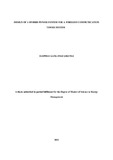Design of a hybrid power system for a wireless communication tower system

View/
Date
2015Author
Gikungi, Elephas K
Type
ThesisLanguage
enMetadata
Show full item recordAbstract
Telkom Kenya tower systems, especially those located in rough terrain, are currently powered by diesel generator sets. Diesel power generation is associated with several disadvantages which do not make it the best option. Generally, Kenya is blessed with Renewable Energy Resources (RES) which can be utilized at such towers to supply power. This study carried out measurements for wind speeds and solar insolation at Aitong, Narok site and compared these with data from secondary sources. A prototype Hybrid Powered System (HPS) was assembled and installed to record the actual RES available on site.
A HPS system was designed based on the data collected. The design process basically involved selecting the best combination of HPS system components based on their cost and power characteristics. Finally, the study compared the designed power system and the current online system at the site in terms of cost of implementation and running.
The actual on site data indicates that there is abundant RES at this site. The obtained data agrees well with data from the secondary sources consulted. The correlation is particularly close in the case of National Aeronautics and Space Administration (NASA) data. The system design optimization shows that a Net Present Cost (NPC) cost of KES 2.6 million against that of the current system of KES 21 million can be expected. The simulated Cost of Energy (COE) for the month of October is approximately Kenya Shillings (KES) 10/kWh which is better than that of Kenya Power and Lighting Company (KPLC) at KES 21/kWh over the same period
Publisher
University of Nairobi
